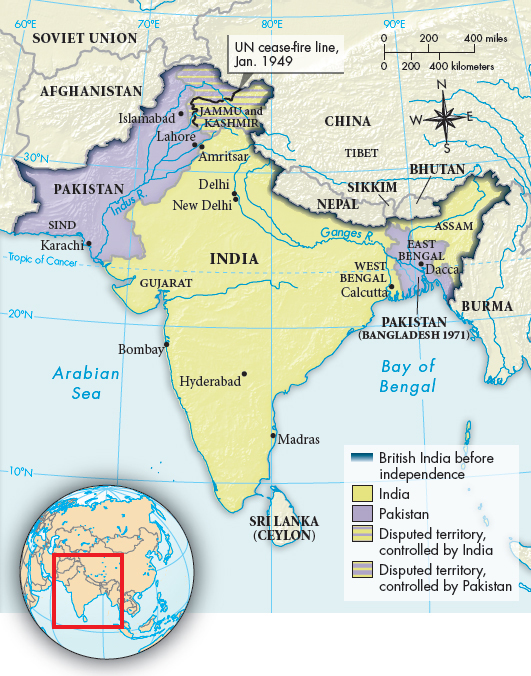Understanding World Societies:
Printed Page 962
Independence in India, Pakistan, and Bangladesh
World War II accelerated the drive toward Indian independence begun by Mohandas Gandhi (see “The Roots of Militant Nonviolence” in Chapter 29). In 1942 Gandhi called on the British to “quit India” and threatened another civil disobedience campaign. He and the other Indian National Congress Party leaders were soon after arrested and were jailed for much of the war. Meanwhile, the Congress Party’s prime rival skillfully seized the opportunity to increase its influence.
The Congress Party’s rival was the Muslim League, led by the English-

Britain agreed to speedy independence for India after 1945, but conflicts between Hindu and Muslim nationalists led to murderous clashes in 1946. When it became clear that Jinnah and the Muslim League would accept nothing less than an independent state of Pakistan, the British mediated a partition that created a predominantly Hindu nation and a predominantly Muslim nation. On August 14, 1947, India and Pakistan gained political independence from Britain as two separate nations (Map 31.2).
Massacres and mass expulsions followed independence. Perhaps a hundred thousand Hindus and Muslims were slaughtered, and an estimated 5 million became refugees. Gandhi labored to ease tensions between Hindus and Muslims, but in the aftermath of riots in January 1948, he was killed by a Hindu gunman who resented what he saw as Gandhi’s appeasement of Muslims.
Jawaharlal Nehru (1889–
The Congress Party leadership pursued nationalist, state-
At independence, Pakistan was divided between eastern and western provinces separated by more than a thousand miles of Indian territory, as well as by language, ethnic background, and social custom. The Bengalis of East Pakistan were neglected by the central government, which remained in the hands of West Pakistan’s elite after Jinnah’s death. In 1971 the Bengalis revolted and won their independence as the new nation of Bangladesh after a violent civil war. Bangladesh, a secular parliamentary democracy, struggled to find political and economic stability amid famines and flooding.